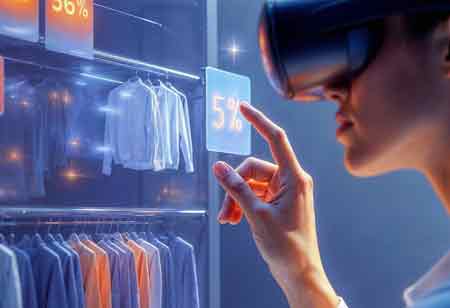THANK YOU FOR SUBSCRIBING
Exploring Latest Trends Shaping Modern Retail
In today’s competitive landscape, retail technology is transforming the retail industry by improving user experience.

By
Apac CIOOutlook | Monday, November 06, 2023
Stay ahead of the industry with exclusive feature stories on the top companies, expert insights and the latest news delivered straight to your inbox. Subscribe today.
The retail industry is on the cusp of transformation, characterised by novel trends like omnichannel shopping, sustainability and personalisation.
FREMONT, CA: In today’s competitive landscape, retail technology is transforming the retail industry by improving user experience, streamlining operations and driving innovation. Technologies encompassing artificial intelligence (AI), augmented reality (AR), and contactless payments are reshaping how customers shop, offering personalisation, convenience, and security.
Retailers utilise data analytics and automation to optimise supply chains, minimise costs, and enhance efficiency. E-commerce and omnichannel strategies empower users with seamless shopping journeys, bridging the gap between online and offline retail. Facilitating unprecedented opportunities within the retail industry, retail technologies are revolutionising the realm by meeting dynamic customer expectations, bolstering competitiveness, and enabling retailers to thrive in a growing digital and customer-centric landscape.
The Influence of AI and ML in Modern Retail
AI and machine learning (ML) catalyse significant transformation in a contemporary retail environment. These technologies have redefined how retailers operate, engage customers, and make data-driven decisions. AI and ML-powered algorithms facilitate customisation on an unprecedented scale. These algorithms scrutinise an extensive range of consumer data, enabling retailers to provide tailored product recommendations, pricing, and content. This individual-centric approach bolsters user engagement and drives sales effectively.
In operations, leveraging these technologies streamline inventory management by forecasting demand patterns, minimising excess stock, and preventing stockouts. Dynamic pricing strategies, assisted by real-time data, maximise profitability while guaranteeing a competitive edge within the landscape. AI-powered chatbots and virtual assistants offer an effective user experience by managing inquiries and providing guidance to shoppers. Furthermore, Fraud identification algorithms boost security, safeguarding retailers and customers from potential fraudulent activities or other privacy breaches.
Leveraging AI and ML to streamline supply chains, predict equipment maintenance requirements and provide visual search abilities. These advanced technologies enable retailers to optimise operations, facilitate well-informed decisions and deliver better shopping experiences. In an evolving competitive retail landscape, integrating AI and ML capabilities has become a determining factor for maintaining relevance in the marketplace.
Subscription-based Models and Personalised Services
Another major advancement within retail technology is the subscription models and personalised services. These innovations have risen as important game changers within the retail landscape by transforming customer participation, trust, loyalty and revenue sources. Subscription models craft a constant and predictable income stream for retailers, nurturing strong financial stability and minimising dependence on one-time transactions.
Consumers are attracted to the convenience and value of subscription boxes, which regularly give curated products. This elevates customer retention and offers a continuous touchpoint for retailers to gather data on user interests and behaviours. Additionally, subscription models and personalised services bolster revenue and position retailers at the forefront of consumer-centric retailing in a growing competitive landscape.
Datafication
Deciphering the maximum potential of technology within the retail industry demands retailers embrace and utilise better retail data analytics and insights platforms. These applications empower retailers with the capability to gather an extensive range of data from diverse touchpoints and extract actionable insights from the dataset.
Leveraging data analytics enables retailers to gain a deeper insight into customer behaviour, preferences, and trends. They detect novel patterns, predict demand, streamline inventory, and facilitate well-informed decisions associated with pricing and promotions. These avenues also equip retailers to improve customer experiences by recommending tailored products and targeting market campaigns.
Integration of IoT Devices for a Seamless In-Store Customer Experience
The amalgamation of Internet of Things (IoT) applications in retail stores transforms the in-store customer journey. IoT devices encompassing smart shelves, beacons, and radio-frequency identification (RFID) tags craft a seamless and improved shopping experience. Smart shelves powered by sensors and RFID technology monitor item availability in real-time, guaranteeing that shelves are continuously stocked. This reduces instances of out-of-stock items, delivering customers with products they want.
Beacons communicate with consumers’ smartphones via Bluetooth, providing customised promotions, discounts, and product recommendations as they move through the store. This proactive approach bolsters user engagement and drives sales. Furthermore, IoT applications boost operational efficiency by tracking user foot traffic, facilitating store layout enhancements, and minimising energy consumption via utilising smart lighting and heating, ventilation and air conditioning (HVAC) systems.
Leveraging the capability of IoT empowers retailers to craft more convenient, efficient, and memory in-store journeys, ultimately nurturing consumer loyalty and retention while bolstering their operational effectiveness and profitability.
In a highly competitive business landscape, leveraging retail technology poises to be a determining factor in outpacing other competitors and maintaining a competitive edge. However, bridging the gap between online and offline retail often referred to as omnichannel retailing, stands important in offering customers a seamless and integrated shopping experience. This proactive approach enables consumers to research various items online, visit physical stores and make shopping via their preferred channel. It nurtures customer loyalty by consistently facilitating customer interaction with the brand across diverse touchpoints. For retailers, it provides valuable insights into consumer behaviour and interest, streamlining inventory management and marketing strategies. Transcending the boundaries between online and offline retail empowers enterprises to boost customer satisfaction, drive sales, and stay competitive in an ever-evolving market.





